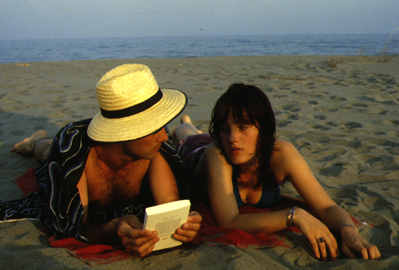Berlin Chamissoplatz (1980)

Berlin Chamissoplatz
West Germany, 112 minutes
Production: Anthea Film, Moana Film (Berlin). Direction: Rudolf Thome. Screenplay: Jochen Brunow, Rudolf Thome. Photography: Martin Schäfer. Music: Ohpsst. Leading Players: Sabine Bach, Hanns Zischler, Wolfgang Kinder, Gisela Freudenberg.
The unusual point to make about Rudolph Thome's latest film is that it represents a rare amalgam of political-social comment and the traditional elements of a love story. Thome, a film critic-turned-director, is one of the major talents of the "New German Cinema” movement of the 1970's, although none of his work has been distributed commercially in America. Berlin Chamissoplatz is his eighth feature, and it is hoped that it will find appreciation with audiences abroad, as it did in Germany last season. The title refers to a street in the Berlin district of Kreuzberg, mostly inhabited by the working class and foreigners. Some time ago, the district was chosen for the government's urban renewal plans. However, as one knows from news reportages, a great protest movement occured in Berlin, when tenant groups and youth organizations rebelled against the destruction of neighborhoods, when unoccupied homes remained intact in more affluent areas. When Chamissoplatz is announced as an area for the reconstruction scheme, the Berlin Senate organized a street festival, in order to inform the inhabitants about the imminent changes. It is during this gathering that Martin, an architect, meets Anna, a young woman who is opposed to the urban renewal idea; she is preparing a video documentary of the event, in order to illustrate her views. When Anna interviews Martin, he is immediately captivated by her, and succeeds in initiating an affair. Thome is no sentimentalist, but he observes the relationship with sympathetic irony. Martin is excited about himself, a man nearly forty, making love to a woman of twenty; they seem to be completely unified. However, the spectator can discern the distance between the lovers' aesthetic impulses: he sings to her as a romantic, and her mind wanders -- she is deeply moved by a Rivette film, and he dozes. The denouement is unexpected, too, like the film as a whole. Berlin Chamissoplatz is as close one as can get to the emotions of two German intelligences who try to be involved with their own worlds, and possibly, beyond.
San Francisco Film Festival 1981

Rudolf Thome's "Berlin Chamissoplatz" is one of those films with all the right ingredients for a success - a love story, a relevant social theme, a veteran NGC director with a reputation for commitment intact, and enough financial backing to assure quality technical credits - but in the end it doesn't convince (although heavily supported by Germany's ace critics). Like so many New German Cinema pix, whats lacking is emotional engagement - the needs of the protagonists are left undefined, which in turn allows for an attentive audience to "read between the lines” in an ongoing dialog with the screen.
Perhaps Thome made a mistake bringing his best film to date to the Hof Film Festival and the German Series of the Berlin fest (English-subtitled German films marked for export abroad) before opening it commercially in the city in which it is set, for as student occupation of old apartment buildings on this Berlin Square and in other sections of town continues, the reality of a mounting social problem dwarfs the limits of a simply constructed love story - to a point that credibility is thrown out the window for something that is generally described as "social engagement." If Thome had set his story in another time and place, chances are that he would have come out a clear winner. So far as foreign auds are concerned, he may still find the echo the film deserves.
"Berlin Chamissoplatz" is about a 40-year-old architect and a 20-year-old student, who meet at a fest on this very square. Since both are on opposite sides of the fence so far as the current plans to raze the area are concerned (to make room for a "redevelopment" project; the story continues along the lines of this hotly discussed social problem as the love story unwinds. There are meetings of the tenants, the publication of a neighborhood newspaper, and exchanges with city officials and house owners over possible resolutions to the conflict. But, in view of the reality of street fighting and the like of late, these "house chats" come off rather lame in the long run. Our lovers even take a few scenes off from the Berlin location to travel overnight to Italy for a brief holiday together, all at the spur of a romantic moment. And, in the end, their own differences are overcome to attempt a match.
Pic's slow pace and stylistic traits (slow dissolve between sequences) allow thesps fortunate breathing space amid strikingly lensed takes, Pic deserves a shot on the fest circuit and in sidebars featuring latest in NGC pix. Offshore art house chances are dim.
Holl. (Ron Holloway) in "VARIETY" 22. 2. 1981